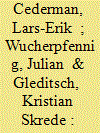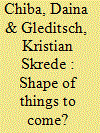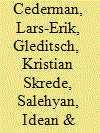|
|
|
Sort Order |
|
|
|
Items / Page
|
|
|
|
|
|
|
| Srl | Item |
| 1 |
ID:
152302


|
|
|
|
|
| Summary/Abstract |
Many scholars have detected a decrease of political violence, but the causes of this decline remain unclear. As a contribution to this debate, we revisit the controversy over trends in conflict after the end of the Cold War. While many made ominous predictions of surging ethnic warfare, Gurr presented evidence of a pacifying trend since the mid-1990s and predicted a further decline in ethnic conflict in an article on ‘the waning of ethnic war’. Leveraging more recent data on ethnic groups and their participation in ethnic civil wars, this study evaluates if Gurr was right about the decline of ethnic conflict, and if he was right for the right reasons. We assess whether an increase in governments’ accommodative policies toward ethnic groups can plausibly account for a decline in ethnic civil war. Our findings lend considerable support to an account of the pacifying trend that stresses the granting of group rights, regional autonomy, and inclusion in power-sharing, as well as democratization and peacekeeping.
|
|
|
|
|
|
|
|
|
|
|
|
|
|
|
|
| 2 |
ID:
152303


|
|
|
|
|
| Summary/Abstract |
We examine if dynamic information from event data can help improve on a model attempting to forecast civil war using measures reflecting plausible motivation and grievances. Buhaug, Cederman, and Gleditsch predict the risk of civil war using a horizontal inequality model with measures reflecting motivation and relevant group characteristics at the country level. The predictions from their model outperform in an out-of-sample forecast conventional country-level models of civil war, emphasizing vertical inequality and country characteristics. However, most grievance measures change little over time. We surmise that a model reflecting potential motivation for conflict can be improved with more dynamic information on mobilization and the behavior of actors. Our conjecture receives some support in the empirical analysis, where we consider both conflict onset and termination over territorial and governmental incompatibilities in the Uppsala/PRIO Armed Conflict Data, and find some evidence that event data can help improve forecasts. Moreover, models with the original grievance measures do better than purely event based models, supporting our claim that both structure and event based components can add value to conflict prediction models. However, the contribution of events to improving predictive power is modest and not entirely consistent, and some types of conflict events seem easier to forecast than others.
|
|
|
|
|
|
|
|
|
|
|
|
|
|
|
|
| 3 |
ID:
120168


|
|
|
|
|
| Publication |
2013.
|
| Summary/Abstract |
A series of studies has shown that civil wars are caused not only by factors inside countries, but also by effects operating across state borders. Whereas a first wave of quantitative studies demonstrated that such effects make the "closed-polity" assumption untenable, more recently researchers have identified particular causal mechanisms driving conflict. Despite these recent advances, a central puzzle remains unresolved, namely why ethnic groups that at least in theory could count on support from large transborder ethnic kin (TEK) groups often have remained surprisingly peaceful, such as the stranded Russian populations in the "near abroad." We propose a theoretical framework that extends the analysis from the primary dyad between the incumbent and the challenger group by adding a secondary dyad that pits the incumbent against the TEK group. We postulate a curvilinear effect of the TEK group's relative size on conflict onset. Using a new data set on transnational ethnic links, we find that that the risk of conflict increases within the middle range of the size spectrum, consistent with our main hypothesis. This means that large TEK groups have a conflict-dampening effect, provided that they control their own state. Excluded TEK groups, however, are not associated with lower conflict probabilities.
|
|
|
|
|
|
|
|
|
|
|
|
|
|
|
|
|
|
|
|
|